Catalog excerpts
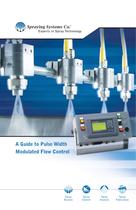
A Guide to Pulse Width Modulated Flow Control Spray Nozzles Spray Control Spray Analysis Spray Fabrication
Open the catalog to page 1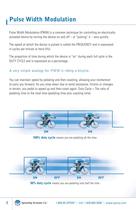
1.800.95.SPRAY | Intl. 1.630.665.5000 | www.spray.com 50% duty cycle means you are pedaling only half the time ON OFF ON OFF 100% duty cycle means you are pedaling all the time ON ON Pulse Width Modulation Pulse Width Modulation (PWM) is a common technique for controlling an electricallyactuated device by turning the device on and off – or “pulsing” it – very quickly. The speed at which the device is pulsed is called the FREQUENCY and is expressed in cycles per minute or hertz (Hz). The proportion of time during which the device is “on” during each full cycle is the DUTY CYCLE and is...
Open the catalog to page 2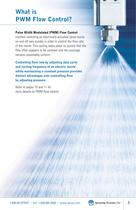
1.800.95.SPRAY | Intl. 1.630.665.5000 | www.spray.com What is PWM Flow Control? Pulse Width Modulated (PWM) Flow Control involves switching an electrically-actuated spray nozzle on and off very quickly in order to control the flow rate of the nozzle. This cycling takes place so quickly that the flow often appears to be constant and the coverage remains reasonably uniform. Controlling flow rate by adjusting duty cycle and cycling frequency of an electric nozzle while maintaining a constant pressure provides distinct advantages over controlling flow by adjusting pressure. Refer to pages 10...
Open the catalog to page 3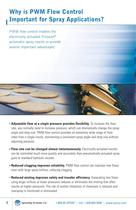
1.800.95.SPRAY | Intl. 1.630.665.5000 | www.spray.com Why is PWM Flow Control Important for Spray Applications? PWM flow control enables the electrically-actuated PulsaJet® automatic spray nozzle to provide several important advantages: • Adjustable flow at a single pressure provides flexibility. To increase the flow rate, you normally need to increase pressure, which can dramatically change the spray angle and drop size. PWM flow control provides an extremely wide range of flow rates from a single nozzle, maintaining a consistent spray angle and drop size without adjusting pressure. • Flow...
Open the catalog to page 4
1.800.95.SPRAY | Intl. 1.630.665.5000 | www.spray.com • Decreased fluid consumption saves money. Improving transfer efficiency and controlling flow rate more precisely can reduce costly chemical usage while maintaining or even improving product quality. • Uniform coating improves quality. Because flow is controlled with duty cycle instead of pressure, drop size and spray angle remain constant. This results in more consistent coating over a wide range of flow rates. • Eliminating atomizing air saves energy. Using PWM flow control, low flow rates that are normally only possible using air...
Open the catalog to page 5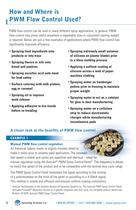
1.800.95.SPRAY | Intl. 1.630.665.5000 | www.spray.com How and Where is PWM Flow Control Used? PWM flow control can be used in many different spray applications. In general, PWM flow control may prove useful anywhere a repeatable dose or consistent coating weight is required. Below are just a few examples of applications where PWM flow control has significantly improved efficiency. • Spraying food ingredients onto products or into trays • Spraying flavors or oils onto bread and pastries • Spraying ascorbic acid onto meat for food safety • Surface coloring with milk protein, egg or caramel •...
Open the catalog to page 6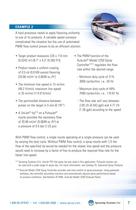
1.800.95.SPRAY | Intl. 1.630.665.5000 | www.spray.com Examp le 2 A food processor needs to apply flavoring uniformly to one of its products. A variable speed conveyor complicated the situation but the use of automated PWM flow control proves to be an efficient solution. With PWM flow control, a single nozzle operating at a single pressure can be used by varying the duty cycle. Without PWM flow control, a spray nozzle with 1/3 the flow of the specified tip would be needed for the slower line speed and the pressure would need to increase by a factor of five to produce the required flow rate...
Open the catalog to page 7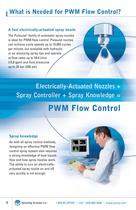
1.800.95.SPRAY | Intl. 1.630.665.5000 | www.spray.com What is Needed for PWM Flow Control? A fast electrically-actuated spray nozzle The PulsaJet® family of automatic spray nozzles is ideal for PWM flow control. PulsaJet nozzles can achieve cycle speeds up to 10,000 cycles per minute, are available with hydraulic or air atomizing spray tips and operate at flow rates up to 59.8 l/min (15.8 gpm) and fluid pressures up to 24 bar (350 psi). Spray knowledge As with all spray control methods, designing an effective PWM flow control spray system also requires a strong knowledge of how liquids flow...
Open the catalog to page 8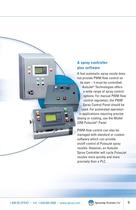
1.800.95.SPRAY | Intl. 1.630.665.5000 | www.spray.com A spray controller plus software A fast automatic spray nozzle does not provide PWM flow control on its own – it must be controlled. AutoJet® Technologies offers a wide range of spray control options. For manual PWM flow control regulation, the PWM Spray Control Panel should be used. For automated operation in applications requiring precise dosing or coating, use the Model 2250 PulsaJet® Panel. PWM flow control can also be managed with standard or custom software which can provide on/off control of PulsaJet spray nozzles. However, an...
Open the catalog to page 9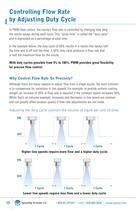
10 1.800.95.SPRAY | Intl. 1.630.665.5000 | www.spray.com 1 Cycle 1 Cycle ON OFF 1 Cycle 1 Cycle 1 Cycle 1 Cycle ON OFF Controlling Flow Rate by Adjusting Duty Cycle In PWM flow control, the nozzle’s flow rate is controlled by changing how long the nozzle sprays during each cycle. This “spray time” is called the “duty cycle” and is expressed as a percentage of total time. In the example below, the duty cycle of 50% results in a nozzle that sprays half the time and is off half the time. A 50% duty cycle produces a flow rate that is half the maximum flow for the nozzle. With duty cycles...
Open the catalog to page 10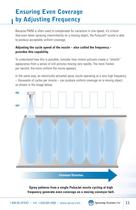
1.800.95.SPRAY | Intl. 1.630.665.5000 | www.spray.com 11 Ensuring Even Coverage by Adjusting Frequency Because PWM is often used to compensate for variations in line speed, it’s critical that even when spraying intermittently on a moving object, the PulsaJet® nozzle is able to produce acceptably uniform coverage. Adjusting the cycle speed of the nozzle – also called the frequency – provides this capability. To understand how this is possible, consider how motion pictures create a “smooth” appearance from a series of still pictures moving very rapidly. The more frames per second, the more...
Open the catalog to page 11All Spraying Systems Co. catalogs and technical brochures
-
G U N J E T® S P R AY G U N S
64 Pages
-
WindJet Air Products
28 Pages
-
Air Atomizing Nozzles
62 Pages
-
Fine Spray Nozzles
16 Pages
-
Hollow Cone Nozzles
42 Pages
-
Flat Spray Nozzles
56 Pages
-
Full Cone Nozzles
52 Pages
-
PWM Spray Control Panel
2 Pages
-
Optimizing Your Spray System
47 Pages
-
AutoJet Gas Cooling System
4 Pages
-
PWM Flow Control
2 Pages
Archived catalogs
-
CU150A GunJet Spray Gun
2 Pages

































